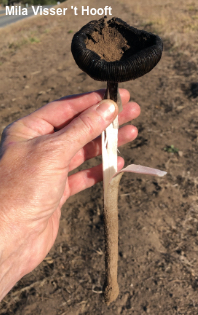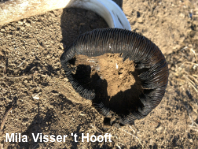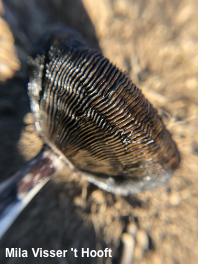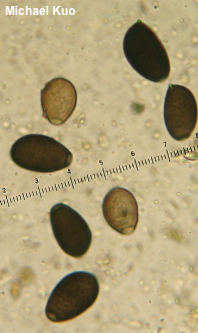| Major Groups > Gilled Mushrooms > Dark-Spored > Coprinoid Mushrooms > Coprinus calyptratus |

|
Coprinus calyptratus [ Basidiomycota > Agaricales > Agaricaceae > Coprinus . . . ] by Michael Kuo Found primarily on the West Coast, Coprinus calyptratus is found of sandy soil in disturbed-ground locations. In some ways it is similar to Coprinus comatus; it is only slightly smaller, its "button" stage is egg-shaped and scaly, it features a long strand of fibers inside its hollow stem, and its gills quickly turn black and begin to dissolve. However, unlike its better-known cousin, Coprinus calyptratus lacks a ring on its stem—and the stem is usually deeply rooted into the soil, with a small basal bulb hidden underground. Additionally, it is "calyptrate" (hence the scientific species name) with a star-shaped patch of universal veil material over the center of the cap, and features much larger spores. Thanks to Mila Visser 't Hooft for documenting, collecting, and preserving Coprinus calyptratus for study; her collection is deposited in The Herbarium of Michael Kuo. Description: Ecology: Saprobic, growing alone or gregariously in urban settings (gardens, landscaping, empty lots, etc.) and in disturbed-ground locations (ditches, roadsides), usually in sandy soil; fall and spring; found mainly in California and the Pacific Northwest but occasionally reported from the Rocky Mountains and Kansas. Cap: At first egg-shaped and whitish-scaly; expanding to broadly bell-shaped, flat, or curled upwards, 4–6 cm across; thin; dark gray to black; finely grooved from the margin to the center; center covered by a whitish to brownish patch of remaining universal veil material that is often covered with sand. Gills: Free from the stem; crowded; soon black. Stem: 5–15 cm long; 0.5–1 cm thick; fairly equal; rooting, with a small, underground, basal bulb; whitish; dry; finely silky; hollow, with a string-like strand of fibers hanging inside; without a ring. Flesh: White; not changing when sliced. Odor and Taste: Not distinctive. Microscopic Features: Spores 17–20 x 10–12 µm; subellipsoid to subovoid; with a large, eccentric, hyaline pore; dark brown in KOH. Basidia 4-spored. Pleurocystidia absent. Cheilocystidia collapsed and poorly defined; subglobose. Pileipellis cutis-like. Veil elements variously shaped; swollen; hyaline in KOH. Clamp connections present. REFERENCES: Peck, 1895. (van de Bogart, 1976; Moreno & Heykoop, 1998; Desjardin, Wood & Stevens, 2015.) Herb. Kuo 08311902. This site contains no information about the edibility or toxicity of mushrooms. |
© MushroomExpert.Com |
|
Cite this page as: Kuo, M. (2019, November). Coprinus calyptratus. Retrieved from the MushroomExpert.Com Web site: http://www.mushroomexpert.com/coprinus_calyptratus.html |



